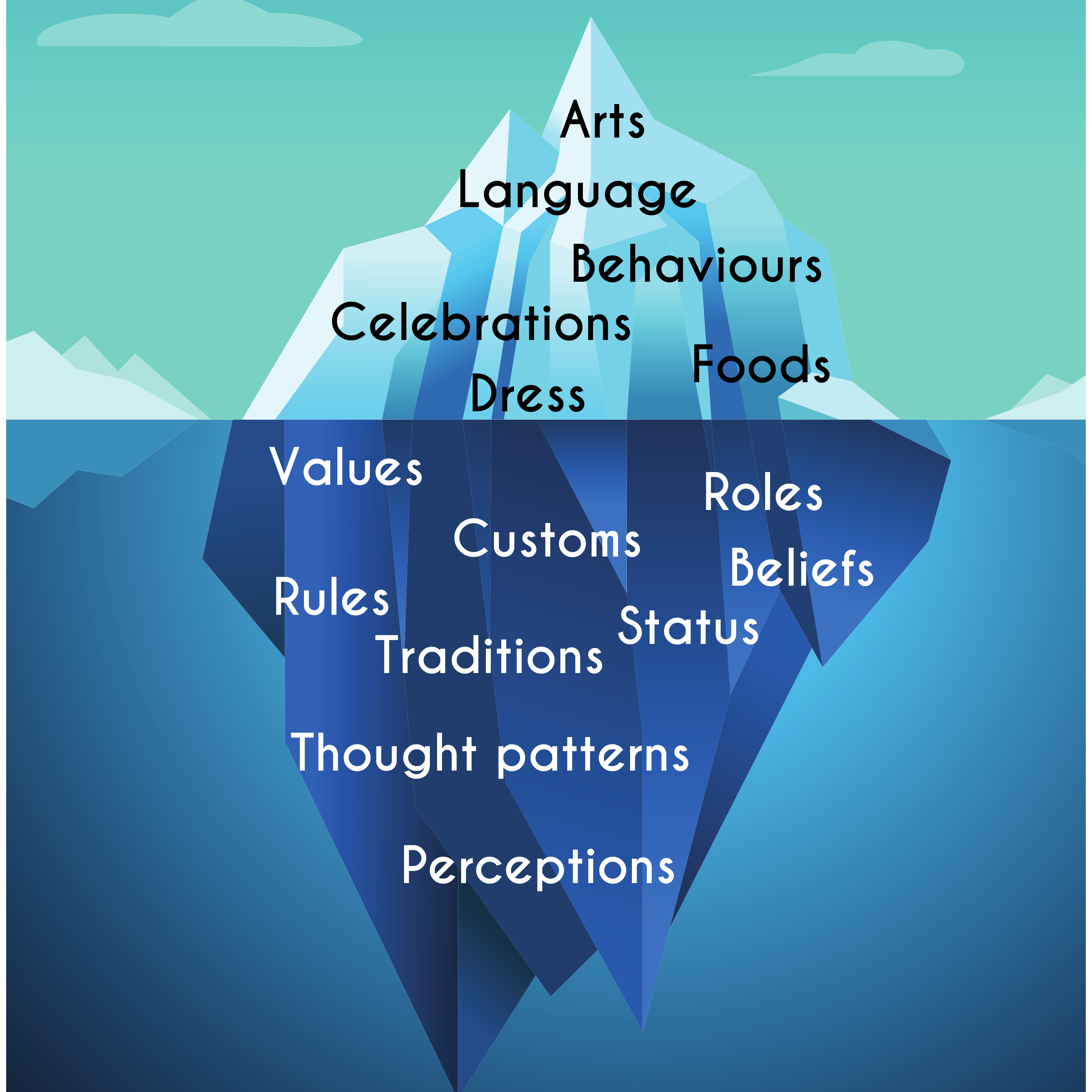
Focus Area 5: Intercultural Engagement
3. Exploring Your Cultural Makeup
Now that you’ve examined what diversity is all about, taken some time to consider your own understanding of race, considered the effects of systemic racism, the dominant narrative, power and privilege, and negative attitudes that get in the way of equality for everyone, you’re in a better position to take on the task of exploring your own cultural makeup.
If you don’t first understand how conscious as well as unconscious prejudice, bias, discrimination, and oppression actually inform your own thoughts and actions toward others that are different from you, then you won’t be able to fully understand and appreciate your own cultural make up.
Coming into this exploration with a more open mind and a balanced perspective of all the plusses and minuses at play in your beliefs and behaviors will shorten your learning curve.
As you begin exploring your own cultural makeup and influences, there are two points to keep in mind:
- Being human, you can be flexible enough to step out of yourself to both view and understand the world from another perspective. In contrast, a fish has no idea it is surrounded by water so it cannot compare itself to the bird surrounded by air.
- Each of us has a tendency to view culture as something unique to others. In order to more fully understand others, you need to reflect on how culture influences you, as well as how it influences others.
Culture is made up of customs, beliefs, values, and behaviors so cultural makeup naturally plays a significant role in shaping a person’s identity. That’s why it’s important to explore your own cultural makeup as you’re working to develop your intercultural engagement.
In the research study, Toward a Culturally Competent System of Care, culture is defined as the “integrated pattern of human behavior that includes thoughts, communication, actions, customs, beliefs, values and instructions of racial, ethnic, religious, or social groups.”1
One easy way to look at culture and visualize how it operates in people’s lives is to picture it like an iceberg. As you can see in this illustration, only the tip of the iceberg is visible above the surface level of the water. Hidden below the surface of the water lies the larger part of the iceberg:

The same can be said about aspects of a person’s culture. Some aspects appear on the surface and are visible to everyone (sometimes called objective culture). But the majority of those aspects remain below the surface, not easily visible to others (sometimes called subjective culture).
The external or surface level aspects of culture that we can most easily spot in others include language, behaviors, appearance, and dress as examples.
Hidden from view are our deeper, less changeable aspects of culture such as values, attitudes, beliefs, and perceptions.
Whether the aspects of culture are visible or hidden, they all form a filter through which people process their experiences. Culture influences people's values, actions, and expectations of themselves. It impacts people's perceptions and expectations of others.
It’s possible that your own deeper aspects of culture may not be completely visible to you, yourself. You may find it eye-opening when you take the time to really delve into those aspects as you are building your cultural self-awareness.
And as you make those discoveries, remember your experience of the process as well as the insights you uncover. That will be useful when you begin to put this exploration into action with the young people you work with. You’ll be able to empathize more and genuinely appreciate what it will take for them to enter into a cultural exchange with you.
CULTURAL SELF-AWARENESS
For you as a youth worker, being able to expand your own worldview to include the values, beliefs, and behaviors of other cultures – especially the culture of any young person in your program – is one of the most important core skills you can develop.
A key to that competency development is to become culturally self-aware.
The importance of exploring your cultural makeup is expressed in this way by Bennet and Schauber, both scholars of intercultural communication:
“Cultural self-awareness is the bridge to learning about other cultures. It is not possible to be truly sensitive to another culture until you are sensitive to your own and the impact that cultural customs, beliefs, values, and behaviors have on youth development practice. A youth worker’s impression of a young person’s behavioral style may be influenced by their own, sometimes unexamined assumptions.” 2
Having an understanding of your own cultural makeup before building an understanding of other's cultural identities is crucial. Don’t short-change this step of the learning process or you’ll risk coming off as inauthentic in your cultural interactions with young people.
Dr. Angela Jackson, President and CEO of Culturally Competent Consulting, states that the culturally aware youth worker appreciates their own cultural makeup and how it influences their lifestyle choices and values. She encourages youth workers to ask themselves the following three questions:
1. “Who am I culturally?”
Start by considering specific dimensions of your culture and social identity such as your:
- Socio-Economic status
- Geographic location
- Citizenship status
- Age
- Education
- Race and Ethnicity
- Religion or spirituality
- Political beliefs
- Sexual orientation
- Gender identity
- Marital status
- Parental status

Reflection Exercise:
There are far too many dimensions of culture and social identity to list them all here. But take a minute to reflect on the list you just read:

2. “How does my culture influence and shape me?”
Being aware of your cultural influences and worldview can help you understand the world from other cultural perspectives.

Reflection Exercise:

3. “How does culture manifest itself?”
Often, we ‘feel’ culture even more than we might actually observe it. How does culture show itself?
- Does culture show itself by what is preferred and valued? (e.g., being extroverted versus introverted; having wealth; performing community service; being humorous; being loyal; achieving individual success versus achieving group/family success; etc.).
- Does culture show itself by what is rewarded? (e.g., specific beliefs, aspirations, or customs; social norms; acceptable and unacceptable behaviors; etc.).

Reflection Exercise:


This exercise is just the tip of the iceberg in terms of exploring your own cultural makeup. Hopefully, it got your wheels turning and if you’re interested in taking a deeper dive to see what’s below the surface, check out the list of exploratory questions in the A Youth Leader’s Guide to Building Cultural Competence - Appendix.3
There are many good resources available to you to dig deeper and explore further and you are encouraged to seek out that information online. This is an ongoing process, learning takes time, and there’s just no way for you to absorb all you need to know from just this brief module. Be intentional about continuing this quest on your own from here.

Shout-out to self-care: NOURISH YOUR BODY AND YOUR BRAIN
1 Toward a Culturally Competent System of Care, Volume I, by Cross, Bazron, Dennis and Isaacs (1989) and Volume II by Isaacs and Benjamin (1991).
2 Bennett, 1998, 2007; Schauber, 2002.
3 Messina SA. A Youth Leader's Guide to Building Cultural Competence. Washington, DC: Advocates for Youth, 1994.
If you prefer to print this section of The Art & Science of Youth Work certificate course, click on the "Print Friendly" icon to select how you would like it to print. You can remove images and icons.
